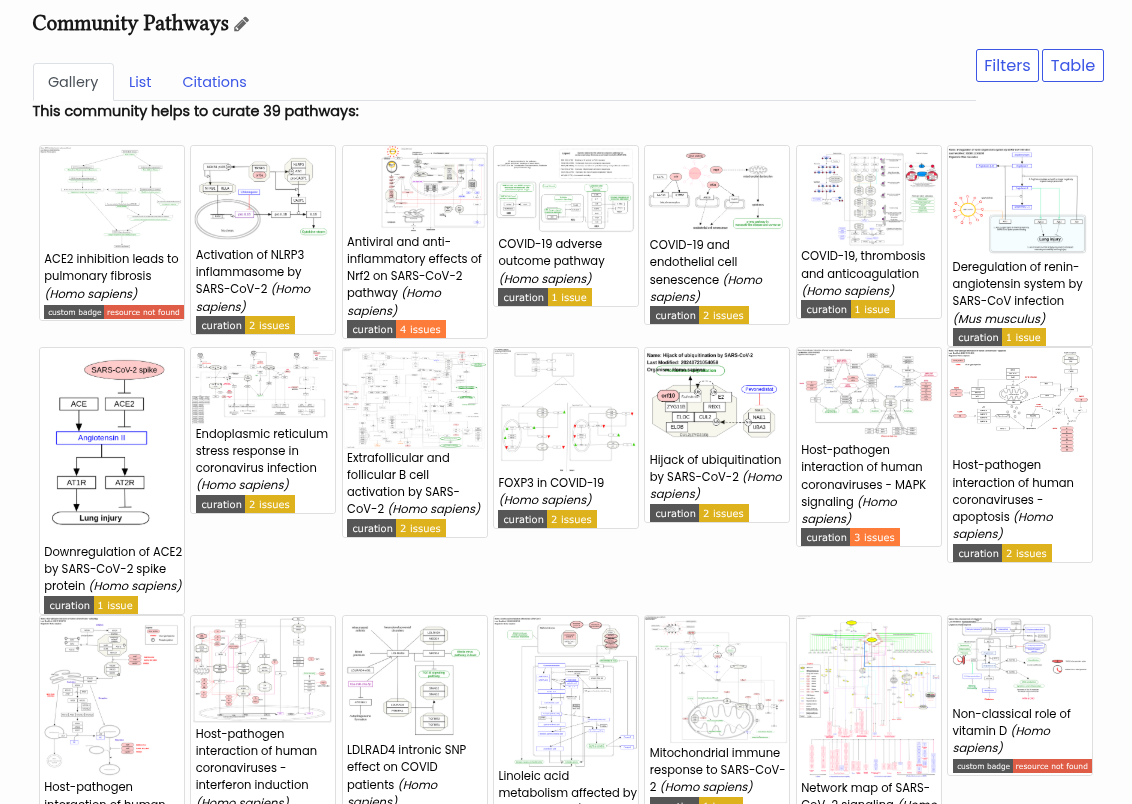Playing with XML+XSLT=SVG because I just hate circos.
“Complex end-to-end tests using #Guix G-expressions” (Sept. 2025)
https://systemreboot.net/post/complex-end-to-end-tests-using-guix-g-expressions.html
Nice post by Arun Isaac showing how to put G-expressions to good use to compose a complex pipeline, in this case illustrated with #bioinformatics.
new blog: "WikiPathways curation reports on profile pages" https://doi.org/10.59350/s7vw2-r7y02 https://chem-bla-ics.linkedchemistry.info/2025/11/30/wikipathways-curation-reports-on-profile-pages.html
Replies to this post show up as comments in the blog post.
@wikipathways still has a good number (200 to 250) pathways that do not have a single reference (which does not mean no references were used): https://www.wikipathways.org/wikipathways-collection/index2#at-least-one-reference
I think we need some gamification here... a few tools that take the GPML or RDF and suggest a relevant lit reference, which then gets posted to this issue tracker (https://github.com/wikipathways/pathway-curation-tasks/issues), listing the WPID and PMID, PMCID, or DOI, and ideally the graphID of the DataNode or Interaction
Playing with XML+XSLT=SVG because I just hate circos.
“Complex end-to-end tests using #Guix G-expressions” (Sept. 2025)
https://systemreboot.net/post/complex-end-to-end-tests-using-guix-g-expressions.html
Nice post by Arun Isaac showing how to put G-expressions to good use to compose a complex pipeline, in this case illustrated with #bioinformatics.
new blog: "WikiPathways curation reports on profile pages" https://doi.org/10.59350/s7vw2-r7y02 https://chem-bla-ics.linkedchemistry.info/2025/11/30/wikipathways-curation-reports-on-profile-pages.html
Replies to this post show up as comments in the blog post.
@wikipathways still has a good number (200 to 250) pathways that do not have a single reference (which does not mean no references were used): https://www.wikipathways.org/wikipathways-collection/index2#at-least-one-reference
I think we need some gamification here... a few tools that take the GPML or RDF and suggest a relevant lit reference, which then gets posted to this issue tracker (https://github.com/wikipathways/pathway-curation-tasks/issues), listing the WPID and PMID, PMCID, or DOI, and ideally the graphID of the DataNode or Interaction
"BioHackEU25 report: Scop3PTM Next - Interactive visualization of PTM data across sequence, structure and interactions" https://doi.org/10.37044/osf.io/xvrud_v1
"Scop3PTM Next was developed during BioHackathon Europe 2025 to address the need for integrated visualization of protein-centric data across sequence (and modification), interaction and structural contexts." https://index.biohackrxiv.org/2025/11/26/xvrud.html
☕ Café #Guix is en English today: long-time contributor Arun Isaac will talk about reproducible computations with Guix and #CWL
📅 today Tue. 25th, 1PM CEST
▶ https://meet.univ-grenoble-alpes.fr/b/cel-dyj-m93-arv
Could anyone point me to #diamondOpenAccess #bioinformatics and computational biology journals, please.
Please boost and post on other social media for wider outreach.
🧬🌱 IPB Halle and @sneumann lab seek a Research Associate in Computational Metabolomics (E13 TV-L, full-time, m/f/d)!
#Bioinformatics, R, Python, stats & #metabolomics. Join an international team!
Apply by 22 Dec 2025
🔗 More: https://www.denbi.de/de-nbi-jobs-portal/1985-research-associate-computational-metabolomics-m-f-d-21-2025 #jobs #openjobs #jobseaker
"BioHackEU25 report: Scop3PTM Next - Interactive visualization of PTM data across sequence, structure and interactions" https://doi.org/10.37044/osf.io/xvrud_v1
"Scop3PTM Next was developed during BioHackathon Europe 2025 to address the need for integrated visualization of protein-centric data across sequence (and modification), interaction and structural contexts." https://index.biohackrxiv.org/2025/11/26/xvrud.html
I blogged my thoughts on receiving generative AI contributions as an Open Source project maintainer https://blastedbio.blogspot.com/2025/11/thoughts-on-generative-ai-contributions.html - seen with #Bioinformatics and #Biopython in particular in mind, but most of these issues are generic to #OpenSource development. It worries me #GenAI
☕ Café #Guix is en English today: long-time contributor Arun Isaac will talk about reproducible computations with Guix and #CWL
📅 today Tue. 25th, 1PM CEST
▶ https://meet.univ-grenoble-alpes.fr/b/cel-dyj-m93-arv
Could anyone point me to #diamondOpenAccess #bioinformatics and computational biology journals, please.
Please boost and post on other social media for wider outreach.

